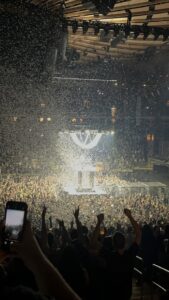
By Rami Mansi
In an era where past pop culture moments and trends are frequently on the mood board for many artists and consumers alike, the once-thriving industry of live music has been one of the lesser talked about aspects. Through overconsumption, rising costs, and an ever-changing music industry, live music is stalled at the sight of these systemic problems. Live-action artistry has been the cornerstone of societies across time, so why have we allowed live music to falter in our sights? Live music should become more accessible to the public, but that raises the question: when and why did live theater stop being easily accessible?
Live music, or live performing arts, such as concerts, broadway, local shows, comedy, or virtually any form of in-person showing or performance, have been held in respect and admiration by the mainstream people. Ranging from the original performances of Shakespearean plays in front of Queen Elizabeth I to your favorite electro-pop artist’s concert, art is meant to be performed live. So, with such a historical background of being loved, what caused the decline of live performances’ popularity?
Focusing on music artists’ concerts such as tours, the first thing to realize is that the love for live performing arts has never declined. We have seen quite the opposite as the demand for live performances surpasses the supply. With such high demand, and after profit-stalling COVID-19, venues have raised the stakes for the artists. If an artist fails to sell out their venue, especially large stadiums, the artists and their team can take heavy losses, according to a report done by NPR. Now at the risk of losing money, artists take more time to build a dedicated fan base before going on tour, therefore creating a less supply of live performances at the ready.
This lack of supply leads to the direct overconsumption of concert tickets. Take a look at Taylor Swift’s Eras Tour tickets from her Toronto Nov. 21 show, where resell tickets are being sold for an obscene price, according to StubHub. This capitalization of concert tickets has taken away chances of concert experience from a dedicated fan who may not be able to afford the high prices offered.
As an avid concert go-er, concerts are such a powerful way to bring people together, including the artist and their fans. Whether finding new friends, meeting up with a social media mutual, or taking a solo adventure, concerts are emotionally driven places where artistry and connections are built.

As a consumer of live music, something that has deterred many of my friends and peers away from live music has been the ever-increasing animosity in the audience. Although venues have become a haven in the modern age, the audience members inside are growing more unsafe: cliques of people keep to themselves, and fans grow more obsessed with the artist, creating a dangerous pit area to put themselves up front.
Consumers of live music have to be not only attentive to the artists, but also to their fellow audience members. Creating a safe space for everyone starts with the artist, but is continued by acts of kindness and good faith in the audience.
Live music is a powerful endeavor for any artist to take on, but in an ever-changing environment, it’s become a scarce reality to experience as a fan. Due to many systemic issues, live music has taken a turn for the worse, but we can all do our parts to make it right for all concert-goers so that they may experience a safe space and get a true concert experience.
The mainstream public should be able to see concerts for a fair price and experience respectful competition between fans; standing for the capitalization of tickets and animosity of other concertgoers has taken away too many concert experiences from people.
We’re all here for a good time, to hear some good music and block out the difficulties we may be facing in our lives. As always, remember to practice good audience member etiquette, because in the concert, we all fam.
